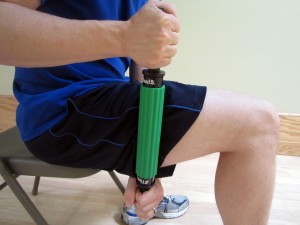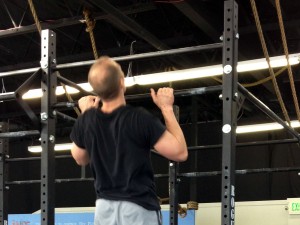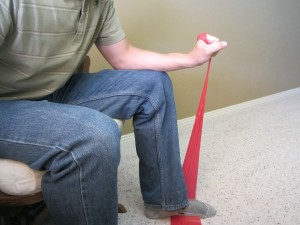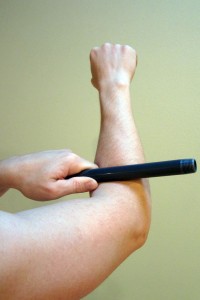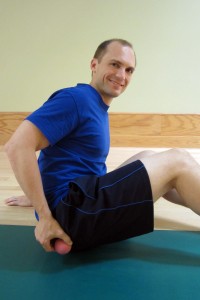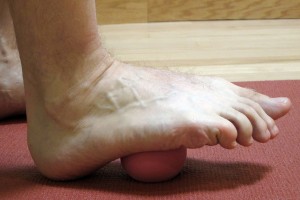Pain in the lateral (outside) leg or knee is commonly associated with a condition known as Iliotibial Band Syndrome (ITBS). (Iliotibial Band Syndrome is also known as IT Band Syndrome, ITB Syndrome, or IT Band Friction Syndrome.) Pain can range from the lateral side of the leg up toward the hip area to just below the lateral side of the knee joint (where the head of the fibula bone begins). The pain can be very debilitating to the point that running or hiking activities have to be stopped. Even walking becomes difficult. I will address the many potential causative factors for IT Band Syndrome and offer advice on how to self-treat this condition.
The IT Band is a very thick fibrous band of tissue that spans from the hip’s origin point at a muscle known as the Tensor fasciae latae (TFL). The TFL transitions into the IT band and progresses down the lateral thigh and ends at the head of the fibula. The IT Band’s primary function is to provide additional lateral support for the knee joint (particularly when standing or landing on one leg). IT Band Syndrome is often associated with an over use injury. It can be very painful, but it can be easily self-treated if you handle your pain and symptoms quickly.
How to Self-Treat IT Band Syndrome:
- Improve your mobility. Mobility issues and myofascial restrictions are highly correlated with ITBS. Tightness in the IT Band or in the deep hip internal or external rotators is a contributing factor to ITBS. The tighter the IT Band, the more likely it will rub on the femoral condyle and develop into pain. Bowlegged describes a medical condition known as a varus deformity, an inward rotation of the tibia resulting in a leg that looks like it is bowed out. It can develop due to chronic friction of the IT Band along the femoral condyle. ITBS may also occur after a total knee replacement (TKA). I recommend using a foam roller to address tightness in the quadriceps or IT Band. To learn how to use a foam roller, please refer to Foam Rolling for Rehabilitation. I also recommend a Thera-Band Standard Roller Massager, which is very firm and allows for a deep amount of pressure. You may also utilize a tennis or lacrosse ball to mobilize the Tensor fasciae latae (TFL) appropriately. The foam roller and roller massager don’t work as well because the greater trochanter of the hip (the boney part of the hip that sticks out) tends to be in the way. Stretching the IT band or the TFL is very difficult, so I tend to utilize other mobilization techniques. However, I recommend a few pelvic and hip stretches. Please refer to IT Band Syndrome Rehabilitation Exercises for my top stretches, foam rolling, and self-mobilization techniques to address IT Band related issues.
- Strengthen your hip muscles. Weakness in the hip external rotators and the hip abductors, like the Gluteus medius and the Tensor fasciae latae (TFL), can lead to IT Band Syndrome. Strengthening of these muscle groups can help avoid future ITB issues as well as reduce your risk of developing Patellar Femoral Pain Syndrome (PFPS). Please refer to Hamstring, Hip Flexor, and Piriformis Stretches for LBP for additional hip and lower leg stretching exercises.
- Over use injury due to downhill running? IT Band Syndrome is often associated with an over use injury. For runners, a common cause of ITBS is running downhill. Few runners actually train appropriately for a race with downhill running. Afterward, they end up with a case of ITBS. I have been guilty of improper training in the past. If you have ever run in the Robie Creek Half Marathon, then you understand the importance of downhill training. To avoid ITBS, adequately train for the downhill portion of the race. Also, vary your running routine and surfaces while training. Although ITBS is often associated with over use, always address other contributing factors as well.
- Check your shoes. Your shoes may be worn out and may be the cause of the pain. If you wear a shoe that helps to limit overpronation, remember that the inner cushion and structure of the shoe can wear out before its outer appearance. If this occurs, the shoe can no longer adequately control inappropriate foot and heel movements such as overpronation. This could result in IT Band Syndrome or other hip, knee, or ankle related issues. Shoes typically only last 350-500 miles. If you are nearing those miles, then it may be time to change. If you’re unsure if your shoes are performing correctly, visit your local running shoe store. The trained staff can inspect your shoes for wear and tear. They may ask you to walk or run in order to watch your gait to fit you in the appropriate shoe. Another option to help control overpronation is an over-the-counter orthotic such as Superfeet Blue Premium Insoles. The blue tends to fit most feet, but a variety of options are available for customization. In my experience, these insoles can last 1,000 to 1,500 miles easily. If the over-the-counter options aren’t helping you, please see a physical therapist or podiatrist for custom orthotics.
- Did you progress too quickly into a minimalistic shoe? If you are used to a standard built up shoe, progressing into a minimalistic shoe may be more difficult and take more time. Unless you are a child or teenager, expect a safe transition to take at least three months. Don’t transition during a period of intense sports. I highly recommend waiting until the off season as progressing slowly is always a better choice.
- Have your gait analyzed while running. Gait or running abnormalities can increase your risk of developing IT Band Syndrome. Over striding tends to occur while running downhill. Scissoring occurs when your leg crosses over the midline with each step. Both over striding and scissoring are easily recognized by a professional. Check with your local running store or a physical therapy clinic for a monthly gait analysis clinic. If you’re unable to obtain a gait analysis, ask your spouse or a friend to video record you (from behind) while you’re running. Then watch the recording to see if you notice either over striding or scissoring.
- Don’t forget to ice. IT Band Syndrome is typically is due to a specific event. Afterward, there is usually an active inflammatory process occurring. I typically apply ice to the lateral part of the knee, but place it on your most painful location. The rule for icing is to apply ice no more than twenty minutes per hour. Don’t place the ice directly against the skin, especially if you are using a gel pack style. Individuals with poor circulation or impaired sensation should take particular care when icing. A bag of frozen peas can be a cheap alternative or you could use one of my favorite gel pack style cold packs.
- Start a supplement. ITB Syndrome is typically associated with a specific event and an active inflammatory process typically occurs. I am a supporter of natural supplements and remedies. Many supplements include herbs which are designed to help reduce inflammation. Phenocane Natural Pain Management combines the following: Curcumin, an herb that reduces pain and inflammation; boswellia, a natural COX2 inhibitor that also reduces pain and inflammation; DLPA, an amino acid that helps to increase and uphold serotonin levels in the brain; and nattokinase, an enzyme that assists with blood clotting and reduces pain and inflammation. If you are taking blood thinner medication, please consult with your physician prior to taking Phenocane Natural Pain Management.
If you’re not experiencing relief after a week or two of aggressively managing the symptoms, contact your local physical therapist for an assessment and help in managing IT Band Syndrome. The American Physical Therapy Association offers a wonderful resource to help find a physical therapist in your area.
Has a specific treatment for IT Band Syndrome helped you? Which treatments haven’t worked for you? Additional discussion can help others to manage this condition more effectively. Please leave your comments below.
Looking for that exercise or book I mentioned in a post? Forgot the name of a product or supplement that you’re interested in? It’s all listed in the new Resource Guide. Check it out today!
If you have a question that you would like featured in an upcoming blog post, please comment below or submit your question to contact@thePhysicalTherapyAdvisor.com. Be sure to join our growing community on Facebook by liking The Physical Therapy Advisor!

